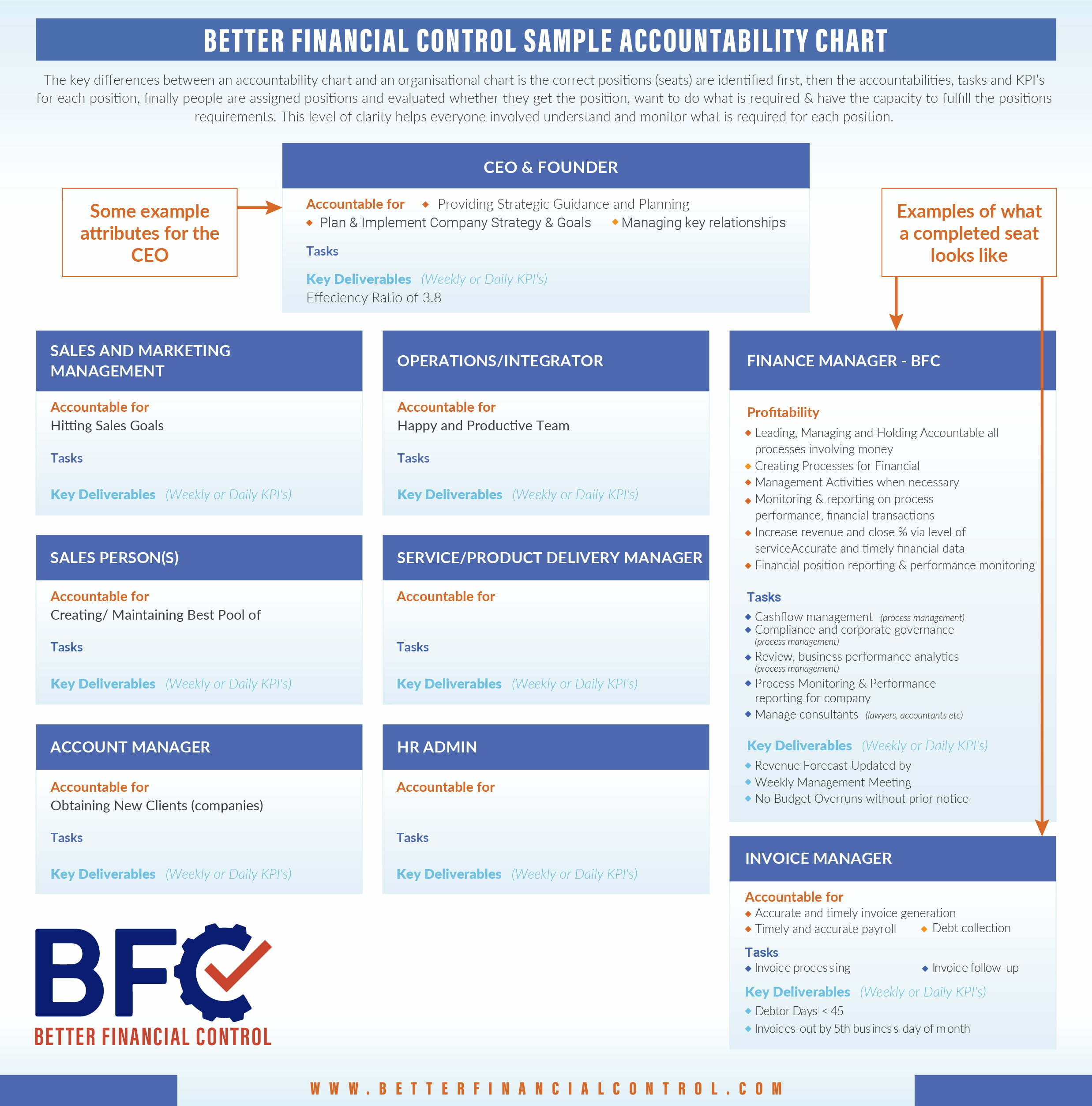Let me introduce you to the second discipline of better financial management: using a Business Accountability Chart.
In our previous article, The Discipline of Company Financial Planning, we proposed the value of consistent planning, strengthening your team’s ability to understand, evaluate and manage your company’s finances.
This was the first of the five vital disciplines for better financial control for your company.
The five disciplines are:
- #1 The Discipline of Practical Company Planning
- #2 The Discipline of Using a Business Accountability Chart
- #3 The Discipline of Effective Management Meetings
- #4 The Discipline of Monitoring a Simple Company Scorecard
- #5 The Discipline of Better Financial Control
Today’s article focuses on creating a company and team dynamic to best define and accomplish such stability. A team’s ability to consistently accomplish its desired financial benchmarks depends on its ability to remain focused, accountable, and aware of how its members are performing.
A Business Accountability Chart, when made correctly, should be the fundamental tool for ensuring your team members have a clear concept of their individual responsibilities and deliverables, and how their role and work integrates with the entire team to achieve your company goals. This article assumes you have created an effective Business Accountability Chart for your company. If you are at all unclear on how to do this, contact us with any questions.
Like all powerful tools, simply having a Business Accountability Chart doesn’t provide any inherent value. It needs to be utilised regularly to generate a positive return on investment.
The following are the three key activities to maximise the extensive benefits in correctly implementing a Business Accountability Chart.
1. Maintaining the correct business accountability structure
Without this deliberate effort, we can often let people in the company slide into doing what they are good at rather than what the company needs. For example, in the case of a recruiting company where I began working, the optimal structure was to have a ‘seat’ for recruiting candidates and another for acquiring companies as clients. The current team members felt they liked doing both candidate and customer acquisition as well as management. Identifying the right seats first allowed the business leader to better clarify the necessary skills and results for each position. They could then talk to their current team members about the requirements for fulfilling each position and thus determine whether they would be a good fit for each of the roles.
Although a Business Accountability Chart shouldn’t change frequently, it is important to review it before determining proposed changes for the company’s direction or desired level of production.
It is important to remember that a person, especially in small companies with only a few employees, can fill multiple seats. The value, then, comes from identifying and monitoring the key deliverables for each of the necessary seats, rather than the staff member. There isn’t any value created just by having one person for each seat; this is just a factor of what the company can afford in terms of staff. Initially, in a company of one, the leader needs to fill each of the seats. As the company grows, those initial seats will be filled by others. As it continues growing, some of the original seats will be divided into more specialised seats with more granular deliverables.
2. Defining & monitoring the correct key deliverables and tasks for business accountability
After optimising the right seats for the company, there is the opportunity to clarify the key deliverables and most common tasks for each seat. This is a wonderful chance to cut through the busy work and define what really matters for each part of the company. This activity ends with the team members becoming much clearer and more accountable for delivering what is needed after accepting responsibility for the seat.


Feelings of fear and being overwhelmed can occur when people see the details involved in what is being asked of them. Effectively defining what is required to be successful in any given seat will go a long way toward making team members feel both accountable and confident to deliver!
The final step in this key activity is to identify the key performance number(s) for the seat. This is as much an art as a science, and it often takes a while to settle in on the best number (or numbers). The aim is to identify a small set of performance figures that can be measured weekly to represent whether the seat’s key deliverables are being generated. These weekly numbers can then provide feedback on how people are performing in any given seat.
If you are not familiar with identifying and monitoring key performance indicators (KPIs), you can feel free to contact us with any questions.
3. Using a ‘People Analyser’ tool to monitor your staff members’ ability to perform as part of the team and deliver in their specific seat(s)
Too often, we don’t provide solid periodic reviews for our staff, simply telling ourselves ‘they know how we feel about themselves and their performance levels.’ In reality, they often don’t know and are nearly always looking for more specific guidance on how they can improve or be worth more to the company.
A People Analyser-type tool is perfect for identifying an employee’s strengths and weaknesses. It allows you to weed out the bad apples that may be getting results for the company but who are actually destroying the culture and effectiveness of the team as a whole. A strong team will outperform any individual, and it takes courage to remove a performer for the benefit of the team; doing so is likely the single most important discipline a business leader can maintain.
When measuring or analysing a team member’s performance, first review how well they embody your company’s Core Values. Simply compare them to the list of core values, deciding if they “regularly”, “occasionally”, or “do not” demonstrate each one in turn. Any ‘Do Not’ answers are likely a real problem for your team dynamics and should be taken seriously. The Occasionally items should be talked about in their review. The Regularly items should be acknowledged in thoughtful ways, from a simple commendation to bonuses or rewards.
The second part of the People Analyser process is evaluating the employee’s ability to generate their necessary deliverables. There are three important questions you want to ask to measure the person’s performance:
- Do they fully understand the seat’s deliverables and dynamics?
- Do they want to perform and deliver on these activities?
- Do they have the actual ability to perform the necessary activities to achieve the required outcomes?
These are great questions to consider before working with the employee accordingly. So much of job satisfaction comes down to being able to perform well on what is required of the job. When the person fits the requirements, they are more likely to do well. When they are a poor fit, problems are going to persist, which undermines the entire team.
The effective use of Business Accountability Charts can be a game-changer for companies. We hope this article has provided you with some specific ideas and opportunities to elevate your company’s chart to the next level.
If you would like further advice on implementing your Business Accountability Chart, or wish to discuss any of the Five Required Disciplines of Business Management, please don’t hesitate to contact Better Financial Control.

